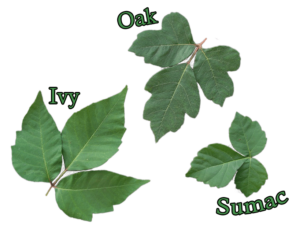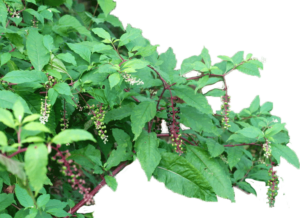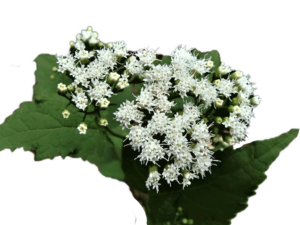Dangerous Plants
There are a few deadly plants in Arkansas, hemlock being one of the most common. It has tall, hollow stems with purple spots and small white flowers in umbrella-like clusters. All parts of the plant, including the leaves, stems, and flowers, contain potent neurotoxins that can be lethal if ingested.
spots and small white flowers in umbrella-like clusters. All parts of the plant, including the leaves, stems, and flowers, contain potent neurotoxins that can be lethal if ingested.
If someone accidentally ingests hemlock, it’s considered a medical emergency, and they need to seek immediate medical attention. The treatment may involve supportive care, like maintaining a clear airway and providing oxygen if needed. In severe cases, they might use antidotes or activated charcoal to counteract the effects of the toxin.
Now, let’s talk about poison ivy, poison oak, and sumac. They are plants known for causing allergic  reactions in many people including me. Poison ivy has that classic three-leaf arrangement, and the leaves can vary in size and shape. The culprit behind the allergic reaction is an oily resin called urushiol, which causes skin irritation, itching, redness, and blistering.
reactions in many people including me. Poison ivy has that classic three-leaf arrangement, and the leaves can vary in size and shape. The culprit behind the allergic reaction is an oily resin called urushiol, which causes skin irritation, itching, redness, and blistering.
So, if you come in contact with these plants, make sure to wash the affected area with grease cutting dish soap and water right away.
 Pokeberry, it’s a tall plant with dark purple berries. While birds can eat the berries without harm, they are toxic to humans, especially the roots and seeds.
Pokeberry, it’s a tall plant with dark purple berries. While birds can eat the berries without harm, they are toxic to humans, especially the roots and seeds.
If someone ingests pokeberry, they should seek immediate medical attention. The treatment may involve supportive care to manage symptoms like vomiting and diarrhea.
Now, be extra cautious with jimson weed! It’s also known as devil’s snare or thorn apple. It has trumpet-shaped flowers and distinctive spiny seed capsules. This highly toxic plant contains tropane alkaloids and can cause severe poisoning.
apple. It has trumpet-shaped flowers and distinctive spiny seed capsules. This highly toxic plant contains tropane alkaloids and can cause severe poisoning.
If someone ingests even a small amount of jimson weed, they should immediately seek medical help. The treatment may include activated charcoal and medications to manage symptoms like hallucinations and rapid heartbeat.
 As for buttercups, they are those bright yellow wildflowers. They are generally not fatal, but they contain irritating substances that can cause skin irritation and discomfort. Just try to avoid touching them to prevent any skin reactions.
As for buttercups, they are those bright yellow wildflowers. They are generally not fatal, but they contain irritating substances that can cause skin irritation and discomfort. Just try to avoid touching them to prevent any skin reactions.
Regarding snakeroot, it refers to various species, some of which are highly toxic and can cause severe symptoms like tremors and seizures in both livestock and humans. The, like hemlock are small bunches of white flower.
toxic and can cause severe symptoms like tremors and seizures in both livestock and humans. The, like hemlock are small bunches of white flower.
If you suspect exposure or ingestion of snakeroot, get medical attention right away. Treatment may involve supportive care to manage symptoms.
Lastly, we have mushrooms, and some of them can be toxic, even deadly. If someone ingests any unknown or potentially harmful mushroom, it’s crucial to seek immediate medical help. Keep a sample of the mushroom for identification if possible, but don’t induce vomiting without medical guidance. Treatment will depend on the specific species ingested and the severity of symptoms. So, better safe than sorry, right? Always be cautious when dealing with wild mushrooms, and never consume them unless you’re sure they’re safe.
List of dangerous mushrooms:
- Amanitas
- Big Red False Morel
- Destroying Angel
- Gabled False Morel
- Jack-o-lantern
- Little Brown Mushroom
- Pigskin Puffball
- Green-Spored Lepiota
- Emetic Russula
- Deadly Galerina
- Emetic Russule
Explore with
confidence
Inspiration and guidance for wherever your trail may lead.
